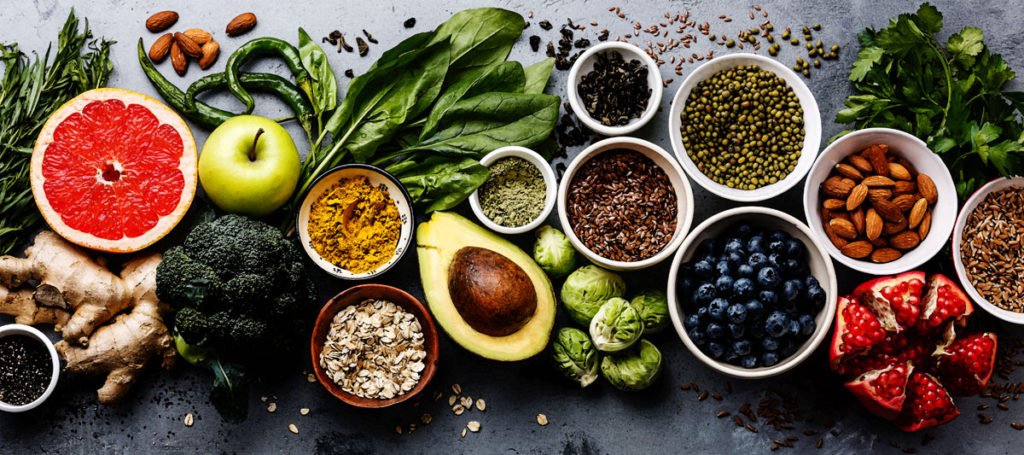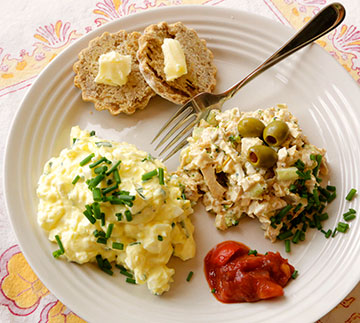It is important for those of us on a gluten-free diet to have foods on hand that we can eat without fear. Most of us have learned to make sure there is something hidden in the cupboards or freezer that we can use to make a meal even when the rest of the kitchen is a bit bare.
Lessons we’ve learned from good cooks in our past have imparted their inspired ways to cope and live well.
Our family still tells tales of a great, great, Aunt who was known for feeding people during the Great Depression. She was quite a miracle, it seems. She always had something she could, as she said, “Scare Up For Dinner.” Why she could even feed a guest or two extra without notice since, in those days, some visiting stranger on hard times would be told, “You go on down the road, and Aunt Sally will feed you…”
Old Ways Become New Again
It has only been in the last thirty years or so that you could go to a grocery store and find almost everything available all the time. Seasonal and regional shopping plans were used as a matter, of course. Some of these ways can come in handy now. More and more people are growing small gardens.
During the pandemic, we found that store shelves of some gluten-free items from time to time were empty of our favorite brands or those we knew were safe for our gluten-sensitive lifestyle. Multiply with possibly having some other food sensitivities as well, and you have a situation where extra planning is needed.

During the pandemic, I reverted to some old ways. I developed an every three-week shopping plan that allowed for some foods that would help us manage in case we needed to be sheltered in place a bit longer than expected.
We also work from home, so making some foods that can be re-purposed for more than one meal is important as a time-saving method. We keep regular business hours and more, often working early in the morning and later at night. Taking time for food prep. and relaxing during meals is all part of our routine. We also had to find ways to exercise at home and go for walks close by. Since our extended family is not geographically close, we also scheduled time for virtual visits to keep upbeat and not get discouraged. It can start feeling lonely at times.
Although working at home is not as new to us as it is to many, the pandemic curtailed many of the outings that we had taken in the past, either for meeting clients or visiting family and friends. This blog is about food, but that said, food fits in at least three times a day. It fits in between work and when you are hungry, you want something good that you can whip up… or as Aunt Sally used to say, “Scare Up.”
Below is a short example of the basics of gluten-free grocery shopping.
Make a list of the staple foods you need to make meals, snacks, etc., and the amounts that you require. I am making meals for two adults. This shopping plan is adaptable for whether you are stocking up on gluten-free items or others. Rather than focusing on individual items, you choose from food groups and in-season readily available produce as much as possible.
Yes, going shopping with a definite list does help but keeping open to items that are in season or on sale and then making meals based on those things can come in handy for numerous reasons. It is a practiced skill, but when you can go to the kitchen, look in the fridge or cupboards, see what is in there and make a meal based on that, you are more independent. Of course, some things require particular ingredient lists, but ad hoc cooking is fun too. When working from home, it helps to plan what you are going to make for dinner ahead of time. I like to create oven meals that I put together in the morning to marinate all day. Then an hour or so before dinner, depending on the cooking times, I will put them in the oven and go back to work. At quitting time, dinner is ready. Well, except for maybe a salad or other such thing, which I sometimes try to make earlier and refrigerate until dinner time.
Shopping in Food Categories from Short to Long Shelf-Life means you can plan meals and your budget.
Planning your food purchases this way can allow you to do a larger shopping once every two weeks for fresh supplies with longer shelf-life foodstuffs that you replace from one month to six months, depending on the amounts you purchase. Buying in bulk when you know your family’s requirements means you can save money and time and have food on hand for unforeseen circumstances.
When you shop, you focus on purchasing amounts that fit your family and space. I like to use up all the freshest ingredients first and clear the fridge to clean it out before the next trip. The medium shelf-life items are used next, and lastly, the long shelf-life items. Then you can re-stock as needed. With this sort of method, you have basics to cook with. When the freshest ingredients are mostly used up, you can still make good meals using a combination of dried, tinned, and frozen foods.
Most whole foods in the following lists, if unprocessed, are naturally gluten-free. Any food that is processed, packaged, etc., must be certified gluten-free unless you use this list for a non-gluten-free diet.

Fresh Vegetables
Short shelf-life
- asparagus
- basil
- bok choi
- beet tops
- broccoli
- cauliflower
- celery
- cilantro
- collards
- corn
- chives
- dandelion greens
- eggplant/aubergine
- endive
- fiddleheads
- green beans
- green onions/spring onions/scallions
- ginger
- cucumber
- kale
- lettuce
- mushrooms
- mustard greens
- okra
- parsley
- peas
- Peppers
- spinach
- sprouts
- swiss chard
- tomatoes
- watercress
Fresh Fruits
- apples
- apricots
- avocados
- bananas
- berries
- cantaloupe/melons
- cherries
- citrus fruits lemons/oranges/grapefruit/
tangerines - cranberries
- figs
- grapes
- kiwi
- kumquat
- loganberries
- loquat
- lychee
- mango
- mulberries
- papaya
- peaches
- pears
- persimmons
- pineapple
- plantain
- pomegranate
- plums
- pumpkin
- raspberries
- rhubarb
- strawberries
- watermelon
Baked Goods
Make and Eat or
Freeze to store:
- biscuits
- bread
- cakes
- cookies
- crackers
- muffins
- piecrusts
- pizza
- special treats
- (naturally whole grain flours
that you blend to make the above) - Or purchase ready-made gluten-free items and freeze them.
Fresh Vegetables
Medium shelf-life
- beets
- Brussel sprouts
- cabbage
- carrots
- celeriac
- garlic
- Jerusalem artichoke
- lemongrass
- onions
- parsnips
- potatoes
- radishes
- shallots
- squash all varieties
- sweet potatoes
- turnip small white
- turnip yellow
- yams
Seeds-Grains
Long Shelf Life
- amaranth
- pasta-gluten-free
- quinoa -red/white/black
- rice-black
- rice-brown, short-shelf-life
- rice-red
- rice-white
Fruits Frozen or Tinned
- apricots
- blueberries
- cherries
- cranberries
- lychee
- mango
- mixed fruits
- papaya
- peaches
- pineapple
- pumpkin
- raspberries
- strawberries
Pre-Packaged Long Shelf-Life
Must be certified gluten-free
- baking mixes – or make your own mixes from separate ingredients.
- cereals
- crackers
- oatmeal
- rice-cakes
Condiments
- artichokes
- cinnamon
- dried savory spices
- fire-roasted red peppers
- honey
- jams-jellies
- maple syrup
- mayonnaise
- meat rubs
- nutmeg
- olives
- pesto
- pickles
- preserves
- salad dressings
- salt and pepper
- sugar or substitute
- sun-dried tomatoes
- turmeric
- vanilla
Eggs – Dairy Medium Shelf-life
- cheeses
- cream
- eggs
- milk or substitutes
Vegetables Frozen
Long Shelf-life
- broccoli
- cauliflower
- collards
- corn
- fiddleheads
- garlic
- ginger
- green beans
- kale
- mixed vegetables
- onions
- peas
- peppers
- squash
- tomatoes
Vegetables Tinned
or Dry Uncooked
- all legumes
- azuki beans
- black beans
- black-eyed peas
- butter beans
- chickpeas
- kidney beans
- lentils-red/brown/black
- lima beans
- mung beans
- navy beans
- peanuts
- pinto beans
- soybeans
- split peas
Dried Fruits
- apricots
- blueberries
- cranberries
- figs
- mixed dried fruits
- papaya
- pears
- pineapple
- prunes
- strawberries
Nuts & Seeds
- almonds
- cashews- raw or roasted
- peanuts
- brazil nuts
- flax seeds
- chia seeds
- pumpkin seeds
Beverages
- coffee
- juice
- soft drinks
- tea
- other
Fats & Oils
- avocado oil
- butter
- coconut oil
- olive oil
- shortenings-vegetable or lard
Meats
All are short shelf-life unless frozen
- bacon
- beef
- chicken/foul
- fish/seafood
- lamb
- organ meats/liver
- pork
- sausages or cold cuts
(check for gluten fillers)
The above shopping list is not an exhaustive one. I am sure you have things you will enjoy adding. A balanced diet is a healthy choice.
If you are looking for a way to blend your own flour mixes that work well for various recipes, see my cookbook.




